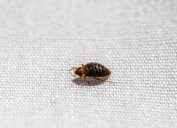This Little-Known Bug Loves Hiding in Your Walls in the Winter—How to Stay Safe
The colder weather can bring about a troublesome insect invasion if you're not careful.
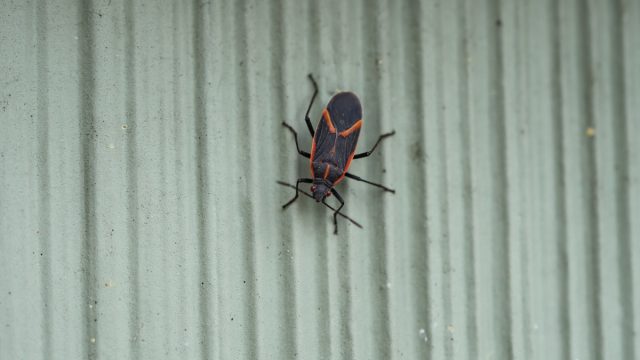
The winter brings about a lot of potential problems for your home: Low temperatures can freeze your pipes, snowstorms can knock out your power, and the cold air can cause your energy bill to skyrocket. But on top of all that, you also need to worry about pests that may be trying to sneak their way into your house—including a little-known bug that loves hiding in your walls during the winter. Read on to discover more about boxelder bugs, and how you can stay safe as the weather grows colder.
RELATED: 5 Smells That Mean Mice Have Invaded Your Home.
Boxelder bugs are usually found outside.
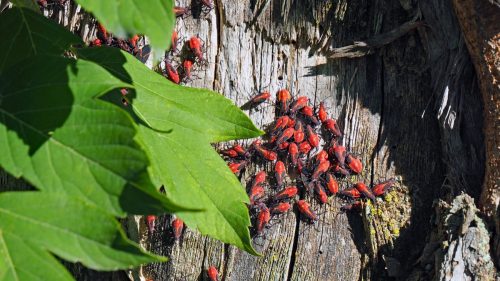
Boxelder bugs are fairly common. While they are native to the western part of the U.S., you can still find them throughout the eastern part of the country, according to Pest World. This black and orange insect can usually be found wherever there is a boxelder tree—which is where it gets its name, naturally.
"Named after the boxelder tree where they are commonly found, boxelder bugs are 'true bugs' in the scientific order Hemiptera, the same order as stink bugs, cicadas, and aphids," says Emma Grace Crumbley, an expert entomologist working with Mosquito Squad. "These true bugs are strictly herbivorous, and their piercing/sucking mouthparts allow them to attack and eat boxelder tree seeds and leaves as well as some fruiting trees."
In other words, boxelder bugs "can't bite you in the same way something like a wasp or ant might, and you won't catch them chewing on your home or furniture," according to Charles van Rees, PhD, conservation scientist, naturalist, and founder of the Gulo in Nature blog.
But that doesn't mean boxelder bugs are something you don't need to worry about, especially in the winter.
RELATED: 6 Ways to Spider-Proof Your Garage, Experts Say.
They may try hiding in your walls in the winter.
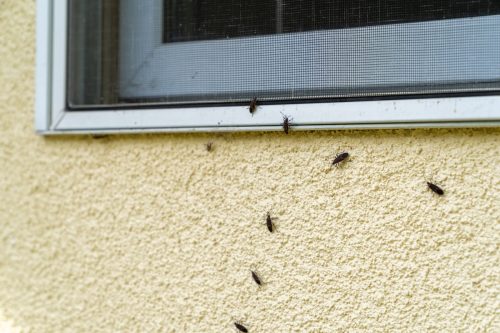
While these insects shouldn't bother you outside, the real trouble comes when the colder weather starts rolling in.
"Just like their cousins the stinkbugs, boxelder bugs survive the winter as adults by hiding in dry, warm places where they can do something kind of like hibernating," van Rees explains.
During the summer months, this pest may hang out on the exterior walls of your house to get some shade from the sun, according to Crumbley. But as soon as winter hits, they can quickly start sneaking their way inside your home.
"Boxelder bugs often invade homes in large groups in an attempt to seek shelter from cold weather," she cautions. "This is when most boxelder bug issues occur."
The best way to stay safe is preventing them from entering your home in the first place.

The boxelder bug's search for warmth can lead them to congregate around places like your windows and doors. They may also go toward basements, garages, and sheds, according to the Farmer's Almanac.
"But once inside, they will seek undisturbed hiding spots, especially inside walls or in dark corners," van Rees adds.
While boxelder bugs won't cause physical damage to your home or pose a threat to your health, experts at the Farmer's Almanac warn that a large invasion can quickly become a major nuisance indoors, as these bugs can leave behind red stains on your clothes or linens.
With that in mind, it's important to know how to stay safe: "As with most insect invaders, the best strategy is to prevent these insects from entering your home," Crumbley advises.
RELATED: 8 Signs of a Bug Infestation You Should Never Ignore, Exterminators Say.
Experts have several prevention tips to help you.

One of the easiest ways to prevent boxelder bugs from coming into your home for warmth this winter is to "limit their access," according to van Rees. "Keep doors and windows shut or use screens," he advises.
You should also make sure the foundation of your home is intact to stop them from sneaking in that way, Crumbley adds.
"Check your house's foundation for any gaps, cracks, holes, or other unwanted entry points where insects can easily get inside," she says. "Reseal where needed."
Pruning the trees and shrubs around your home during the winter will help eliminate the risk of these bugs coming to your home, according to the Farmer's Almanac.
"Regular maintenance of these plants will help minimize the potential habitat for box elder bugs and make your yard less inviting," the experts explain.
You can consider removing boxelder trees from your yard, too—although Crumbley says this is "less effective" at preventing these bugs from being around your lawn or home.
But you can still take action if they've already invaded.
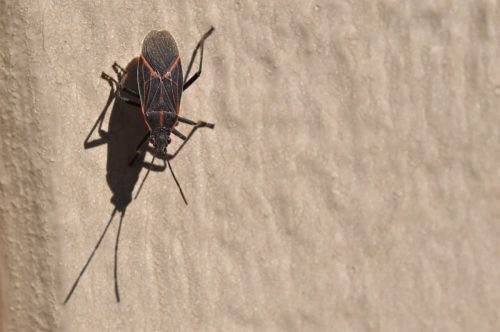
While the best safety method is preventing boxelder bugs from entering your home in the first place, van Rees says your second-best option is to try finding them before hide.
But don't go straight for the kill if you see one running by you. "Boxelder bugs are large and will leave a decent size mark if you try to squish them, and when threatened, boxelder bugs emit a strong and stinky odor to deter predators," Crumbley warns.
Instead, she recommends using a tool most of us already have in the home: a vacuum cleaner.
"Using this to suck up boxelder bugs is a quick and clean method to remove large numbers of them from your space," Crumbley says. "Be sure to dispose of the dryer bag and clean your vacuum out away from the home to prevent re-infestation."
For more home advice delivered straight to your inbox, sign up for our daily newsletter.
